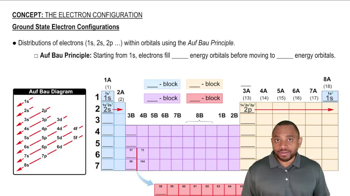Here are the essential concepts you must grasp in order to answer the question correctly.
Electron Configuration
Electron configuration describes the distribution of electrons in an atom's orbitals. It is typically written in a specific format that indicates the energy levels and sublevels occupied by electrons. For example, the configuration for an element like Argon (Ar) is 1s² 2s² 2p⁶ 3s² 3p⁶, showing how electrons fill the available orbitals according to the Aufbau principle.
Recommended video:
Electron Configuration Example
Noble Gas Notation
Noble gas notation is a shorthand method for writing electron configurations by using the symbol of the nearest preceding noble gas to represent core electrons. This simplifies the notation by focusing on the valence electrons, which are crucial for determining an element's chemical properties. For instance, for Arsenic (As), the configuration can be written as [Ar] 4s² 3d¹⁰ 4p³.
Recommended video:
Periodic Table and Electron Configuration
The periodic table organizes elements based on their atomic number and electron configurations, reflecting periodic trends in chemical properties. Elements in the same group typically have similar valence electron configurations, which influences their reactivity and bonding behavior. Understanding the layout of the periodic table helps predict the electron configuration of elements like Arsenic based on its position.
Recommended video:
 Verified step by step guidance
Verified step by step guidance


